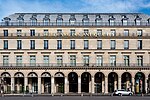Carrousel du Louvre
1993 establishments in FranceBuildings and structures in the 1st arrondissement of ParisLouvre PalaceShopping centres in FranceShopping malls established in 1993 ... and 1 more
Westfield Group

The Carrousel du Louvre is an underground shopping mall in Paris, France, managed by Unibail-Rodamco. The name refers to two nearby sites, the Louvre museum and the Place du Carrousel. The mall contains a famous skylight, La Pyramide Inversée (Louvre Inverted Pyramid), which plays an important role in the best-selling 2003 book The Da Vinci Code. Among other stores, it had the first Apple Store in France, and a McDonald's restaurant, which created controversy at the time.
Excerpt from the Wikipedia article Carrousel du Louvre (License: CC BY-SA 3.0, Authors, Images).Carrousel du Louvre
Rue de l'Échelle, Paris 1st Arrondissement (Paris)
Geographical coordinates (GPS) Address Phone number Website Nearby Places Show on map
Geographical coordinates (GPS)
| Latitude | Longitude |
|---|---|
| N 48.860395 ° | E 2.337599 ° |
Address
Palais du Louvre
Rue de l'Échelle
75001 Paris, 1st Arrondissement (Paris)
Ile-de-France, France
Open on Google Maps










